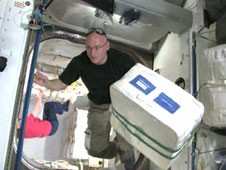Wed, Mar 12, 2014
Study Will Examine Differences Between A Twin In Space And One On Earth
Only one set of twins has ever been into space, and now those twins are providing an unprecedented opportunity for scientists to understand better the effects of microgravity on the human body.

NASA's Human Research Program (HRP) will fund 10 short-term, first-of-its-kind investigations into the molecular, physiological and psychological effects of spaceflight in a continuous effort to reduce the health impacts of human space exploration. The National Space Biomedical Research Institute is partnering with HRP to provide genetic counseling and assisting in the management of the research.
This unique opportunity is made possible by NASA's decision to fly veteran astronaut Scott Kelly aboard the International Space Station for one year, beginning March 2015, while his identical twin brother, retired astronaut Mark Kelly, remains on Earth.
This study will focus in part on the comparison of blood samples collected from Scott and Mark at regular intervals before, during and after the one-year mission. Physiological and psychological testing also will be conducted on the brothers before, during and after the mission.

Scientific and technical experts from academia and government reviewed 40 proposals submitted in response to the research announcement "Human Exploration Research Opportunities - Differential Effects on Homozygous Twin Astronauts Associated with Differences in Exposure to Spaceflight Factors." The 10 selected proposals, which are from 10 institutions in seven states, will receive a combined $1.5 million during a three-year period.
HRP regularly assesses crew health and performance during spaceflight to evaluate associated risks. From these assessments, HRP develops strategies to monitor and mitigate these risks. These studies often have the considerable added benefit of advancing health care for people on Earth.
(Pictured: Scott Kelly in top NASA image, Mark Kelly in lower photo)
More News
Airport Marking Aids Markings used on runway and taxiway surfaces to identify a specific runway, a runway threshold, a centerline, a hold line, etc. A runway should be marked in ac>[...]
"It is extremely difficult, if not impossible, for manned aircraft to see a drone while conducting crop-enhancing and other aerial applications at low altitudes and high speeds. We>[...]
Aero Linx: The Skyhawk Association The Skyhawk Association is a non-profit organization founded by former Skyhawk Pilots which is open to anyone with an affinity for the A-4 Skyhaw>[...]
“The T-54A benefits from an active Beechcraft King Air assembly line in Wichita, Kansas, where all required METS avionics and interior modifications are installed on the line>[...]
Aero Linx: Aerostar Owners Association The Association offers the Aerostar Owner a unique opportunity to tap an invaluable source of information concerning the care and feeding of >[...]
 ANN's Daily Aero-Term (04.28.24): Airport Marking Aids
ANN's Daily Aero-Term (04.28.24): Airport Marking Aids Aero-News: Quote of the Day (04.28.24)
Aero-News: Quote of the Day (04.28.24) ANN's Daily Aero-Linx (04.28.24)
ANN's Daily Aero-Linx (04.28.24) Aero-News: Quote of the Day (04.29.24)
Aero-News: Quote of the Day (04.29.24) ANN's Daily Aero-Linx (04.29.24)
ANN's Daily Aero-Linx (04.29.24)




